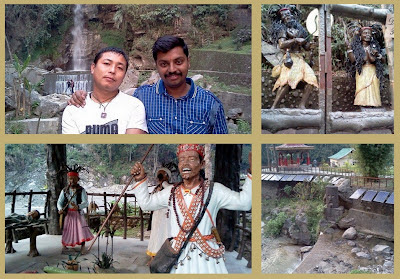 |
| Mt. Kanchenjunga
|
It seemed blisteringly hot at Bangalore this March which
made us long for rain or snow. Since Mohammed cannot come to the mountain, the
mountain should go to Mohammed or in our case we should go to the Himalayan
kingdom of Sikkim. Escaping the heat (both of the temperature and of our jobs)
Vasistha and I fled to Gangtok, Sikkim for a weeklong vacation. Having never seen BIAL, the airport was a
pleasant experience for us. Throughout the process of check-in and security
check I’d been aware of a continuous chirping noise. Assuming it was some new
age music from the speakers, I just ignored it. Imagine my surprise when a fat
sparrow landed on my table at the café and started pecking away at the crumbs.
This bird, supposedly extinct in Bangalore is found in abundance at the
airport!
 |
| View from our Aeroplane
|
Our flight took us via Delhi to Bagdogra airport at
Siliguri, West Bengal. It was sweltering at Siliguri after our long hours spent
in AC which led us to wonder if we had landed from the frying pan of Bangalore
to the fire here! Our driver, Pravesh picked us up and off we went to Gangtok.
The weather continued to be dry and hot for more than half of the four hour
drive to our hotel.
 |
| Teesta and Rangeet
|
The road
followed the curves of the meandering rivers, Teesta and Rangeet and wound
through valleys and mountains. Soon enough, we encountered cooler climate and
greener hillsides heralding our entry into Sikkim, locally known as Nye-mae-el
or paradise. The sheer variety in shades
of green of the foliage around us reminded us of Charmudi Ghat of the Nilgiris.
Arriving at the very homely Rhenock House, we were checked
in by the warm and friendly staff. The hotel had a very Colonial feel to it. It was barely 6pm and surprisingly night had
already fallen. Our room was on the
third and highest floor. The twinkling lights spread on the steep slopes of the
city made for a gorgeous view from our window.
 |
| View from our room- The twinkling lights of Gangtok outside our window |
 |
| Music in the lobby |
Eight days might seem too long for a state as small as
Sikkim, but not when it holds so many places to see and things to do.
 |
| Gangtok Flower Exhibition |
Our first day was earmarked for some local sightseeing. The
flower exhibition at the heart of the capital Gangtok has a beautiful
collection of orchids. The amazing colours and textures of these and the other
flowers are a sight for sore eyes. The peaceful temples of Hanumantok and
Ganeshtok just a few kilometers from the city give a great view of Mount
Kanchenjunga, the third highest peak of the world. On a clear day (as it was
for us, fortunately!) one can clearly make out the jagged edges of the
snow-covered peak glowing in the morning sun. It seems just within an arm’s
reach, but is as unattainable for a simple mortal as the moon.
 |
| Dressing up as a Sikkimese and Snow covered peaks |
 |
| Trail through the Zoo |
The sprawling Himalayan Zoological Park is home to some rare
species of Pheasants, the Red Panda, the Snow Leopard and to a wide range of
animals, of which only a select few are caged. The steep winding slopes of the
park loop through the fir trees of the hillside and need a trekker’s physique
for proper exploration.
 |
| Panther |
Sikkim is also known for its adventure sports. We decided to
go Paragliding and signed up at one of the roadside shops. Weighing us up
(literally and figuratively), the owner quoted the price to be Rs.2350/- per
person for a 10 minute flight. We were driven up a cliff for 15 minutes
followed by a trek on foot, up an exceedingly steep trail to the top for a
further quarter hour. Huffing and puffing, I barely had time to swallow a few
mouthfuls of water before my pilot securely strapped us both to a seat harness
and tied the glider to his back. He also gave me a long pole attached to a
video camera and casually instructed me to run off the cliff! Needless to say,
I did not share his blithe disregard for my life. I experienced a moment of muscle
freezing, heart stopping fear, and then Shangri-La! The wind had caught me at
the moment of fall and was like a living entity. I was gliding at an astounding
speed, buffeted by the stiff breeze which pushed and pulled and kept trying to
sweep me off to distant lands. If not for the pilot behind me, I’d have reached
who knows where?
 |
| Ready for take-off! |
The landing is another experience that I will recount to my
grandkids. I was moving slowly in a lull
in the wind. Suddenly, a strong gust caught me and I felt like I was at the top
of a giant roller coaster, poised to fall to my doom. In spite of the sudden
loops and twirls my pilot succeeded in letting me down gently. The adrenaline
rush was a constant companion, but it was exhilarating.
 |
| Pravesh and Vashu at Ban Jhakri Falls with the solar panels :) |
The hydel project of Banzhakri falls was our last stop for
the day. Very scenic and well maintained, it is a governmental initiative for
green energy conservation & generation. The whole park is powered by solar
energy. Life-like statues of Banzhakri (Shaman of the local tribes) are placed
at strategic places throughout this energy park. There is also a small museum
where you can play quizzes about energy conservation and some models of green energy
products.
All in all, it was a very successful first day of our little
trip.














































